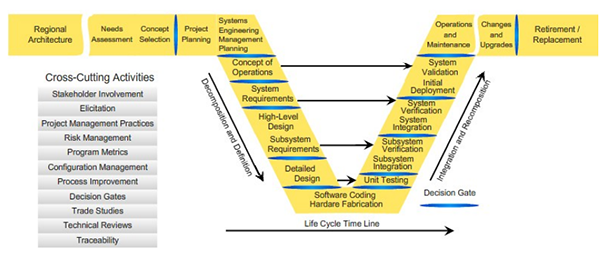The Intelligent Transportation System Joint Program Office’s (ITS JPO) Connected Vehicle (CV) pilot deployment program seeks to spur innovation among early adopters of CV application concepts. The pilot deployments are expected to generate findings, insights, best practices, lessons learned, and technical documentation which can be leveraged by other CV technology deployments. The Wyoming DOT (WYDOT) CV Pilot Program has provided a lot of valuable feedback to the early CV technology deployer community in the use of the technology to mitigate safety impacts of inclement weather in rural corridors as well as lessons learned about deploying connected vehicle technologies and using ITS/CV standards. Key among the outputs of WYDOT’s CV Pilot is the set of systems engineering documents that were developed following the “V” model systems engineering approach (see FHWA’s V diagram in the figure below).1 These systems engineering documents include Concept of Operations, System Requirements document to Detailed Design Documents and Verification Test Plans and Procedures – developed throughout the project life cycle beginning with the concept/project planning phase to validation/operations & maintenance/changes & upgrades phase.

Systems Engineering “V” Diagram
The Colorado Department of Transportation (CDOT) is deploying roadside infrastructure to begin leveraging the benefits of connected vehicles throughout the state. Colorado is building a transportation system with an end goal capable of communicating with connected vehicles at a significant scale. CDOT is building the tools it needs to communicate directly to drivers right when they need it to avoid crashes and improve traffic flow for everyone. As part of realizing this vision, CDOT staff embarked on a one-day working visit to WYDOT’s Traffic Management Center (TMC) in Cheyenne, Wyoming to learn about WYDOT CV Pilot systems engineering experience. The WYDOT CV Pilot systems engineering team walked the CDOT delegation through the systems engineering process and documents. WYDOT noted that the system engineering documentation requirements were overwhelming at first; however, has paid off in the long term. The documentation has been beneficial to the team during testing, software/firmware/hardware updates, and serving as reference materials when staff/vendor change, or project scope expanded. Issues relating to CV technology vendor selection, CV applications development, encoding/decoding of CV messages/data were of high interest to CDOT.
In addition, CDOT was very interested in WYDOT’s integration of CV data with data from other existing systems and how the fused data is used to generate and disseminate Traveler Information Messages (TIMs). Specifically, CDOT sought explanations on the data architecture, data flows from Roadside Units (RSUs) through the Operational Data Environment (ODE) to the Pikalert and Data Broker (DB) and the return of TIMs to equipped CVs on the road through the ODE and RSUs. The WYDOT CV Pilot systems engineering team used the systems engineering documents to address all CDOT questions. CDOT continues to interact and collaborate with WYDOT CV Pilot team on systems engineering issues. From CDOT’s viewpoint, the availability and thoroughness of WYDOT CV Pilot’s systems engineering documents continues to aid them tremendously in developing and integrating their CV technology into existing transportation systems.
The City and County of Denver (CCD), Colorado is deploying CV applications as part of its Advanced Transportation and Congestion Management Technology Deployment (ATCMTD) grant. CCD plans to implement a connected TMC through this program. To support this effort CCD will implement connected traffic signals, connected fleet vehicles that will support three base projects: freight efficiency CV applications (along designated freight corridors), pedestrian safety applications, and an Enterprise Data Management (EDM) system for the TMC. The CCD ATCMTD team’s initial assessment of CV technology revealed that the technology was not initially fully matured and required working with vendors and other jurisdiction’s experiences to help develop the tools for deployment. One of the many jurisdictions that the CCD ATCMTD team paid a working visit to was the WYDOT TMC in Cheyenne, Wyoming. The WYDOT CV team engaged the delegation from CCD and walked them through their implementation. WYDOT also shared their systems engineering documents with CCD.
The CCD ATCMTD team leveraged systems engineering process from the WYDOT CV Pilot as a base to generate their own system engineering processes and documentation. These include the following: Concept of Operations, Systems Engineering Management Plan, and System Requirements. WYDOT also discussed with the CCD ATCMTD team technical issues they ran into. From CCD’s standpoint, their engagement with WYDOT CV Pilot team as well as the use of WYDOT’s systems engineering documents helped them to leverage lessons learned and avoid many potential mistakes.
The most obvious lesson from this success story is that the time and effort utilized in developing and updating systems engineering documents for the CV Pilot program is worth it. These documents serve as templates for assisting other early CV technology deployments. Final versions of all WYDOT CV Pilot systems engineering documents are available at https://ntl.bts.gov/ntl.